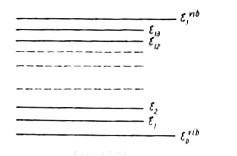The natural angular frequency of vibration of an HF molecule is 7.79×1014 rad/s. There are 13 rotational levels between the zero level and the first excitation level. Estimate distance between the centre of the atoms in this molecule.
The correct Answer is:0.95Å
The diagram of vibration-rotational energy levels is shown in Fig. There are only two purely vibrational levels: εvib0=hω/2andεvib1=3hω/2, and thirteen intermediate vibration-rotational levels:
εl=εvib0+εrotl=hω2+l(l+1)h22J, where l = 1, 2,........, 13
It is clear from the diagram that the fourteenth vibration-rotational level coincides with the first purely vibrational level:
ε14=hω2+14×15h22f=3hω2,where 14×15h22J=hω
This makes it possible to determine the molecule.s moment of inertia about its centre of mass: J=105h/ω. On the other hand, the moment of inertia is J=mHr2H+mFr2F,where rH+rF=d is the distance sought between the centres of atoms and mHrH−mFrF. But mF−19mH. Therefore rH 19rF 19d/20. Substituting into the expression for the moment of inertia, we obtain
J=mHrH(rH+rF)=1920mHd2
For the distance between the centres we obtain
d=√2.1×103h19ωmH

Similar Questions
Find the angular velocity of rotation of a hydrogen molecule on the first excited rotational level, if the distance between the centres of its atoms is 0.74 Å.
View SolutionThe natural frequency of vibrations of a nitrogen molecule is 4.4×1014rad/s. Find the temperature at which vibrations of the nitrogen molecules are excited.
View SolutionDetermine the angular rotation velocity of an S2 molecule promoted to the first exccited rotational level if the distance between its nuclei is d=189pm
View SolutionFor an HF molecule find the number of rotational levels located between the Zeroth and first excited vibrational levels assuming rorational states to be independent of vibrational ones. The natural vibration frequency of this molecule is equal to 7.79.1014rad/s and the distance between the nuclie is 91.7pm.
View SolutionThe natural vibration frequency of a hydrogen molecule is 1.26×1014 Hz. Find the zero-point energy of the vibrations of the molecule. Can the vibrational degrees of freedom in the molecule be excited at 600 K?
View SolutionThe natural vibration frequency of a hydrogen molecule is 1.26×1014 Hz. Find the zero-point energy of the vibrations of the molecule. Can the vibrational degrees of freedom in the molecule be excited at 600 K?
View SolutionVander Waal's constant 'b' of a gas is 125.57 centilite/mol. The nearest distance between the centes of the two molecules is x×10−7cm
View SolutionThe natural vibration frequency of a hydrogen molecule is equal to 8.25.1014S−1, the distance between the nuclei is 74pm, Find the ratio of the number of these molecules at the first excited vibrational level (v=1) to the number of molecules at the first excited rotational level (J=1) at a temperature T=875K. It should be remembered that degeneracy of rotational levels is equal to 2J+1.
View SolutionFind the number of ratational levels per unit energy interval, dN/dE, for a diatomic molecule as a function of rotational energy E. Calculate of an magnitude for an iodine molecule in the state with rotational quantum number J=10. The distance between the nuclei of that molecule is equal to 267pm.
View SolutionThe distance between the atomic centres in a nitrogen molecule is 1.094×10−10m. Find the moment of inertia of the molecule and the temperature at which molecular collisions cause the state of the rotational motion to change.
View Solution
